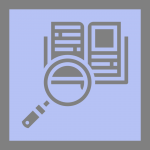Would you like to listen to this post instead?

Components of a Thesis Paper
In this month’s post will be exploring some of the common components that occur in a dissertation or a thesis. These components may occur in a slightly different order than presented here. The most common components are:
- Abstract
- Introduction
- Literature Review
- Methodology
- Presentation of the research
- Conclusion
- Bibliography
Depending on the length of the project that you must write, and the requirements for your field of study, there may be other components that you need to include.
Make sure that you check the specific format requirements for your project with your supervisor and your faculty.

Abstract
An abstract is a component of a thesis or dissertation that must come at the start of the project. It is a summary of your work and gives a brief overview about all the different sections in your project.
It should include the following points:
- The purpose of the research: what it’s about and why that’s important.
- The methodology: how you conducted your research.
- The key research findings: the most important results.
- The implications of these key findings: what you think the most important affects these findings will have.
In general, the structure of your abstract should copy that of your project. If you have five sections listed (Introduction, Literature Review, Methodology, Research and Conclusion) in your project, then you should summarise each section in a sentence or two. These sentences should also appear in the same order that your sections occur in your project.
If you have more than five sections, you will have more sentences.
The Abstract and Bibliography are considered separate to the main body of the project, and so are not listed in the Abstract itself. Neither are appendices, figures, tables, glossaries or maps and diagrams of any kind.
Introduction
The Introduction is where you welcome your reader into your project. This is where you lay out your argument for why you conducted your research and why it is important.
You should include a clear example of the Research Question which you used and the aims of your research.
Depending on the advice of your supervisor, you may include a brief description of where your project initially started, and how you came to formulate your final Research Question. Using this method may allow you to demonstrate how your research changed from its initial iteration to its final, focused form.

Literature Review
This component is a critical evaluation of the resources (literature) which you gathered and read for your dissertation or thesis.
You will not list or use all the resources which you have explored in your research. The Literature Review is reserved for the most important pieces of literature which are relevant to your field of study.
It is partially a survey of the most relevant work in the area you are researching and is used to demonstrate that you are up to date with the scholarly work in that area.
There are many different ways of structuring your Literature Review. Below are four common types to consider:
- Chronological
- Thematic
- Methodological
- Theoretical
Chronological
This structure outlines the development of the topic in question over time. Don’t just list everything in order of occurrence and summarise it. You will need to show that you understand the literature and the development of the research.
Analyse patterns, turning points and key debates in the field. Give you opinion on how or why certain developments occurred.
Thematic
This structure organises the literature into different themes. These themes should be derived from the literature itself, not imposed upon the resources.
You can divide the themes into subsections and compare and contrast themes or subsections.
Methodological
Sometimes you will collect resources which are from different academic fields, or which use a variety of research methods.
If this is the case, comparing and analysing the different research methods may be useful. Particularly if you are exploring which research method may be best for the area you are studying.
You can contrast methods such as quantitative and qualitative analysis. Explore how research has been considered from different frameworks such as empirical or theoretical scholarship. Or group the literature into different topics and see how the differing methodologies affect the research in that topic.
Theoretical
A Literature Review may also be used to set up a theoretical framework for your project. A theoretical framework is a foundational review of the most important existing theories in your field of research. It acts as a roadmap for developing the arguments you will use in your own work.

Presentation of the Research
This is the biggest part of your project. Depending on the requirements of your paper, this may consist of only one to two chapters, or it may be a multi-chapter section.
Take the time to lay out your research in clear steps. Back it up with the data that you gathered. This can take the form of:
- Direct quotations
- In-line citations
- Diagrams
- Maps
- Charts
- Images
- Tables
Conclusion
This part ends the main body of your project. Any support material such as appendices and bibliography occur after this section.
Your Conclusion is the most important part your project. This is where you finalise your argument, which you:
- outlined out in your Introduction,
- supported with your choice of resources in your Literature Review,
- explained how you conducted your research in your Methodology,
- laid out your results in your Presentation of that research.
In your Conclusion, you will need to:
- give an overview of your project (make sure it is worded differently to your Introduction),
- draw out key aspects of the literature you used,
- give your recommendations,
- explain how they are justified or contradicted by your research.
A thesis or dissertation is supposed to allow you to prove that you have the necessary academic and research skills to be awarded your qualification. It is also an opportunity to contribute to the academic community by showing how your work can contribute to the wider research being done in your field.
Bibliography
A bibliography is a list of all the resources which you have consulted during the course of your research. It should be placed as the last component in your project.
Bibliographies should be constructed so that the author or creator’s names are listed in an A-Z list. The author or creator’s family name is placed before their personal name, and the A-Z list is then constructed.
Depending on the referencing style that is needed for your project, the sequence in which information about the resource you are listing can differ. You may also be required to submit a reading list as well. A reading list is the list of all the resources which you refer to directly within your project. It is also constructed as an A-Z list using the author or creator’s family name first.
For more information on referencing, please see our LibGuides, or our previous posts and podcasts on using EndNote and Cite-Them-Right.
